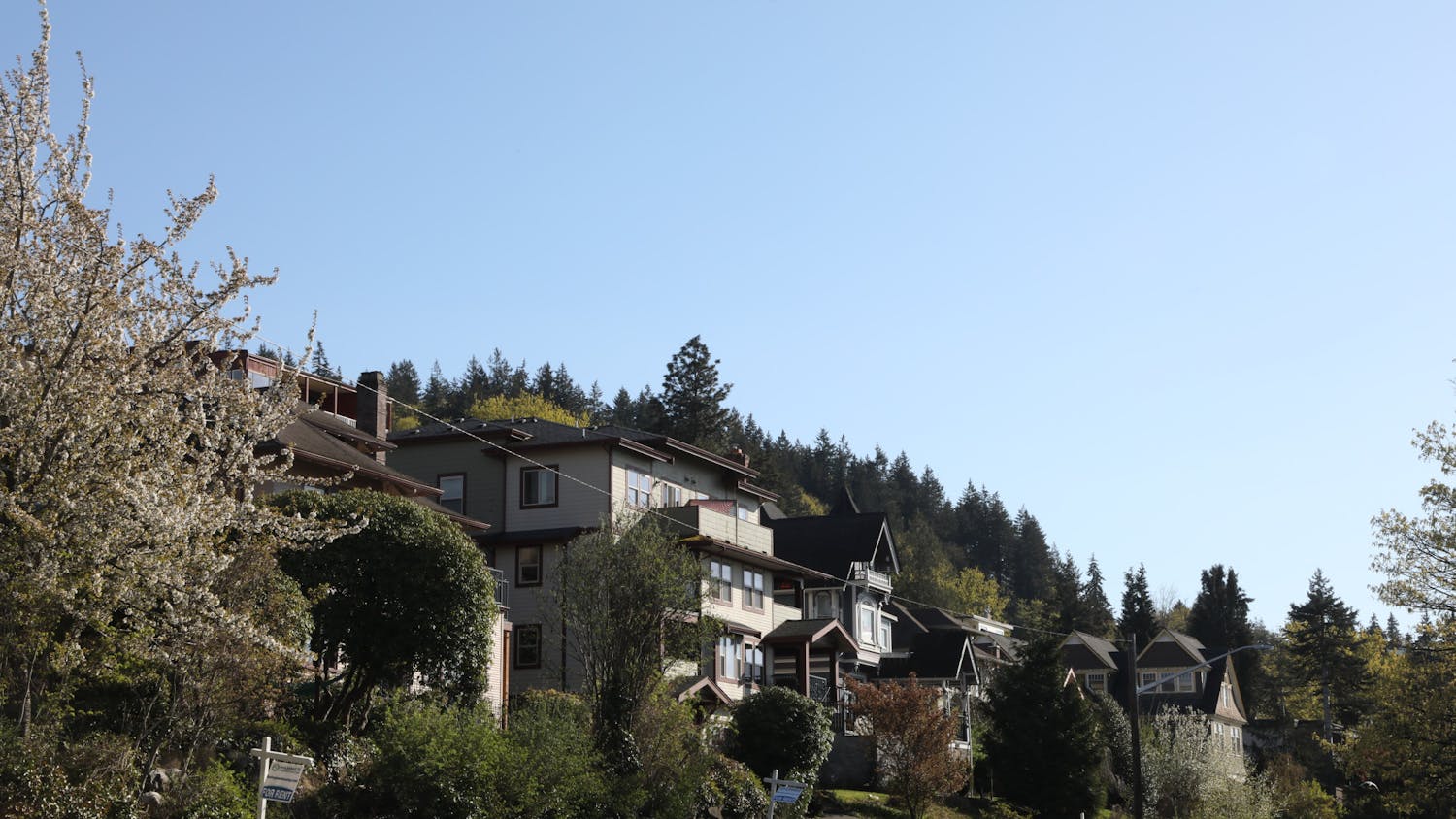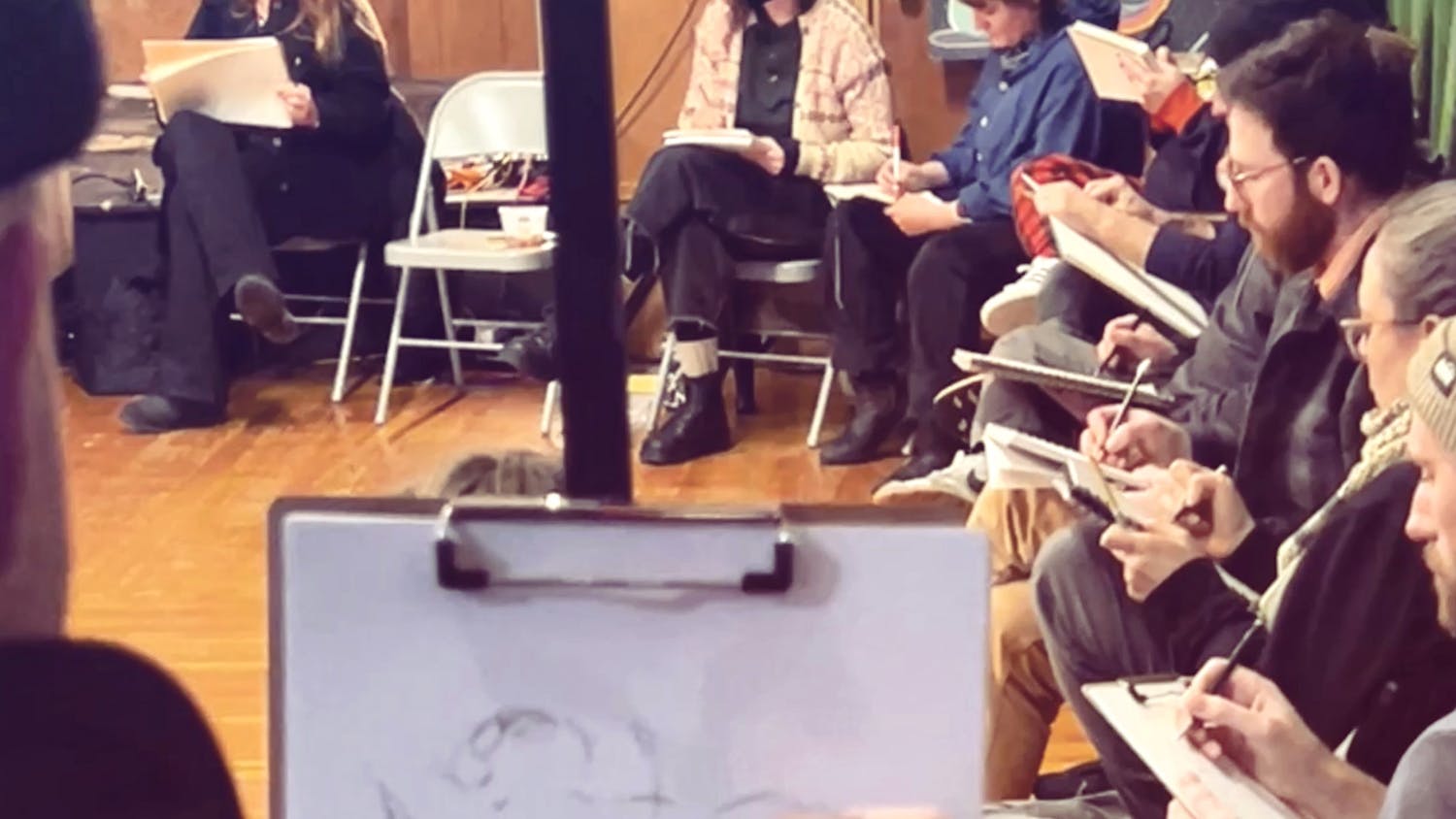Jeff Jewell stands proudly in his office. // Photo by Tanner Thompson
By Tanner Thompson
A foggy glass wall illuminates 15 wooden frames presenting century-old images of Whatcom County, lining the second floor hallway of the Lightcatcher Building in downtown Bellingham. The wall is part of the newest exhibit in the Whatcom Museum, “All is Not Lost.”
The photos in the exhibit come from fragile glass negatives that have been mishandled for years. The negatives are all unique with scratches, breaks, water damage and even mold. The Marketing and Public Relations Manager Christina Claassen said that this was not your typical photo exhibit.
“When you see these types of old photographs they are usually touched up digitally,” Claassen said. “These do the opposite.”
This is exactly what curator Jeff Jewell was going for when finding photos for this exhibit, he said.
“I wanted to show something recognizable but also something that was verging on not being easily repaired,” Jewell said. “I was going to show it with all of its warts and blemishes.”
Jewell is Whatcom Museum’s Photo Archives research technician. He said he has been working at the archives on Prospect Street for 26 years, and enjoys working with people and taking care of the almost 185,000 photos that are in the archives’ storage. Jewell said that him and the people in the Photo Archives center are in constant pursuit of historic images of Whatcom County and are dedicated to keeping them safe in storage.
As the research technician, Jewell said he takes on the roles of both photo archivist and historian for the museum, curating multiple exhibits and displaying them around the county.
Jewell said the Photo Archives are a useful resource for people when it comes to history, research and art; whether they’re a student looking for pictures for a project, someone with genealogy inquiries or businesses that want a photo to display.
Jewell said “All is Not Lost” has been in the works for about a decade. He said it was important for him to find glass negatives that were interesting visually but also clear enough for viewers to identify what's in the photo. Jewell found these images to be important because some of them are the only images of historic moments in Whatcom.
“When they are not identified, that's where the tricky part is. When you look at this and you go, ‘Hmm where is this? What is this?’ that's also the fun part.”
It's almost like a mystery game trying to identify what is in the photos, Jewell said. With parts of images gone, he had to rely on visual clues and his knowledge of Whatcom history to figure out what was going on in the photos.
[caption id="attachment_31857" align="alignleft" width="300"] The photo exhibit lines the walls of Whatcom Museum. // Photo by Tanner Thompson[/caption]
The exhibit features a variety of both well-known and unknown photographers. One of the most prominent photographers who contributed was J. Wayland Clark. This amateur photographer was active in Whatcom in the early 1900s. Jewell said that he took pictures for the love of taking pictures.
Jewell said he remembers when photo archivists recovered Clark’s collection of glass negatives from his garage, which was torn down following his death. The photo archivist at the time saved the photos from the wreckage and now the photos are used in this exhibit.
Jewell said one of his favorites in the collection is the photo titled “The Rain Parade.” An unknown photographer took the image in 1924 during a rainy day parade on East Holly and Cornwall Avenue, he said. The piece is only a quarter of the original image.
Jewell said he had a hard time with this particular glass negative as it was glued on to another by water, making the emulsions stick together. He had to pry the two negatives apart until they seperated, leaving one of the negatives destroyed, but the other turning out interesting, he said.
“It’s very artistic, but then when I got to think about it, if it’s made by mold, water and the elements, who is the artist of this piece of art? It's like time itself almost,” Jewell said.
This exhibit will stay in the Lightcatcher Building through January 2020.
This story was updated on 5/13/2019 to correct the spelling of Christina Claassen's name.
The photo exhibit lines the walls of Whatcom Museum. // Photo by Tanner Thompson[/caption]
The exhibit features a variety of both well-known and unknown photographers. One of the most prominent photographers who contributed was J. Wayland Clark. This amateur photographer was active in Whatcom in the early 1900s. Jewell said that he took pictures for the love of taking pictures.
Jewell said he remembers when photo archivists recovered Clark’s collection of glass negatives from his garage, which was torn down following his death. The photo archivist at the time saved the photos from the wreckage and now the photos are used in this exhibit.
Jewell said one of his favorites in the collection is the photo titled “The Rain Parade.” An unknown photographer took the image in 1924 during a rainy day parade on East Holly and Cornwall Avenue, he said. The piece is only a quarter of the original image.
Jewell said he had a hard time with this particular glass negative as it was glued on to another by water, making the emulsions stick together. He had to pry the two negatives apart until they seperated, leaving one of the negatives destroyed, but the other turning out interesting, he said.
“It’s very artistic, but then when I got to think about it, if it’s made by mold, water and the elements, who is the artist of this piece of art? It's like time itself almost,” Jewell said.
This exhibit will stay in the Lightcatcher Building through January 2020.
This story was updated on 5/13/2019 to correct the spelling of Christina Claassen's name.





